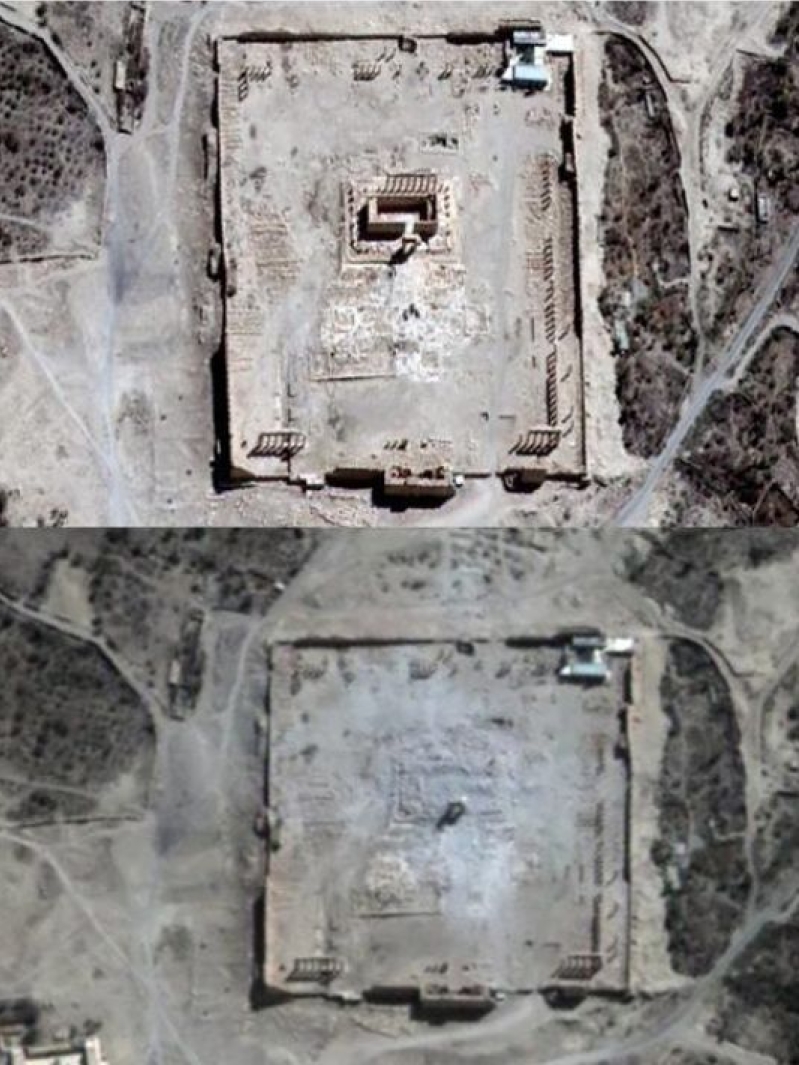
Islamic State militants have demolished the Temple of Bel in Syria's ancient city of Palmyra, one of the most culturally significant pieces of architecture in the world.
The Syrian Observatory for Human Rights said late Sunday that the jihadist group had placed explosives inside the temple, which had been the center of religious life in Palmyra for nearly 2,000 years
Less than 24 hours later, the U.N. training and research agency released satellite images and analysis confirming that the temple had been completely flattened by the jihadist group. UNOSAT Manager Einar Bjorgo told reporters, "We can confirm destruction of the main building of the Temple of Bel as well as a row of columns in its immediate vicinity."
According to the New York Times, the temple was consecrated in A.D. 32 to the Semitic god Baal, and is widely considered one of the most important sites in Palmyra. The report notes that the temple was a "relatively intact example of the fusion of Middle Eastern, Greek and Roman influences."
Mohamed Hassan al-Homsi, an activist from Palmyra, also reported the destruction, revealing the militants destroyed the building using explosives, booby-trapped boxes, and barrels.
"This was the most important temple for tourists and for the people of Palmyra. They used to hold festivals there," he told reporters.
Amr al-Azm, a former Syrian antiquities official who now is a professor at Shawnee State University in Ohio, also told reporters the amount of explosives used to damage to the Temple of Bel was likely extensive.
"This is the most devastating act yet in my opinion. It truly demonstrates ISIS's ability to act with impunity and the impotence of the international community to stop them," al-Azm said.
The attack on the Temple of Baal came less than a week after ISIS destroyed another iconic building Palmyra, the nearby Temple of Baalshamin. The ancient city of Palmyra, which stands in the desert about 150 miles northeast of Damascus, the Syrian capital, is a Unesco World Heritage site.
In the past, ISIS has widely publicized images of its fighters blowing up tombs and destroying statues and religious imagery that it considers blasphemous. The hardline Muslim group considers both Christian "pre-Islamic religious objects or structures sacrilegious," wrote Sturt Manning, chairman of Cornell University's Department of Classics, in an opinion piece for CNN.com.
"It seeks to destroy diversity and enforce narrow uniformity. Evidence of a tolerant, diverse past is anathema," he said. "What it fears is memory and knowledge, which it cannot destroy."
The extremists also recently tortured and executed Khaled al-As'ad, an 82-year-old man who had spent his life preserving antiquities in Palmyra, because he refused to reveal where various irreplaceable relics had been hidden.
At the time, speaking in Washington, State Department spokesman John Kirby released a statement condemning the killing and claiming ISIS' attempts to erase Syrian history will ultimately "fail."
"The United States condemns in the strongest possible terms this murder ... of a man who dedicated his life to preserving Syria's cultural treasures," he said. "Like so many of ISIL's victims, his life and extraordinary work stand in stark contrast to that of his barbaric killers. These attempts to erase Syria's rich history will ultimately fail."







